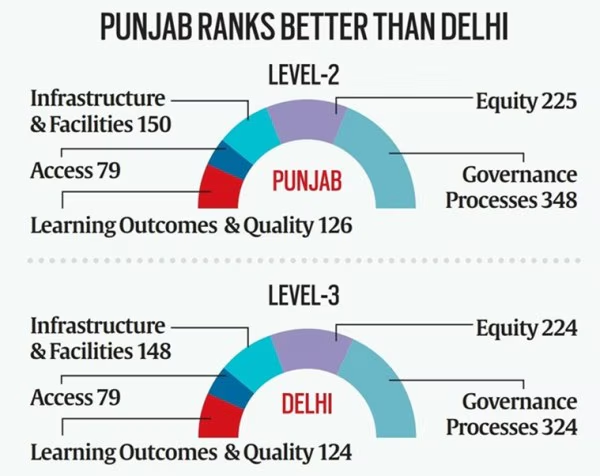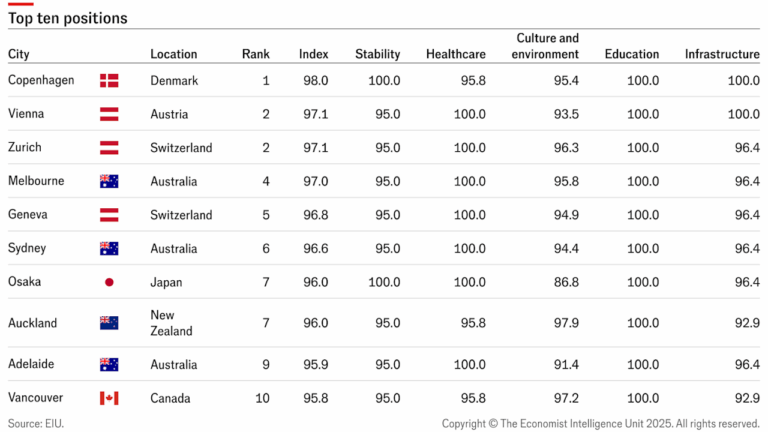Chandigarh Tops School Education Index, Meghalaya Comes Last : PGI 2.0 Report
Why in the News
The Performance Grading Index (PGI) 2.0 for 2023–24, released by the Union Ministry of Education, has ranked Chandigarh as the top performer in school education in India, while Meghalaya has emerged as the lowest scorer.
- This annual report evaluates the performance of all Indian States and Union Territories (UTs) on various education-related parameters.

- The PGI 2.0 is a revamped framework introduced to offer a comprehensive assessment of the school education system, incorporating both outcome-oriented and governance indicators.
- The latest results highlight that no state or UT has yet entered the highest performance band, reflecting the pressing need for systemic reforms.

Background: Understanding the PGI 2.0 Framework
What is the Performance Grading Index (PGI)?
Launched in 2017-18, the PGI is an evidence-based assessment framework developed by the Department of School Education and Literacy (DoSEL), Ministry of Education. It measures the performance of States and UTs against a set of clearly defined indicators.
In 2023, the Ministry introduced PGI 2.0, a refined version aimed at strengthening alignment with the National Education Policy (NEP) 2020, SDG 4 (Quality Education), and outcomes-based governance.
What Does PGI 2.0 Measure?
The PGI 2.0 evaluates States and UTs across six key domains:
- Learning Outcomes and Quality
- Access (enrolment, transition rates, retention)
- Infrastructure and Facilities
- Equity (gender, socio-economic parity)
- Governance Processes
- Teacher Education and Training
Key Features of the 2023 – 24 PGI 2.0 Report
Chandigarh Leads the Nation
- Chandigarh secured a total of 719 points, making it the only region to fall in the Prachesta-1 category (701–760 points).
- This reflects strong performance across learning outcomes, teacher training, infrastructure, and governance.
- As a Union Territory with a small geographic and administrative size, Chandigarh’s focused governance and urban advantage have contributed significantly to its score.
No State Crossed the Top Bracket
- The top performance range (761–1,000) remains unachieved.
- This indicates that even the best performers have yet to meet the optimal benchmarks across all domains.
- Ministry officials highlighted this as a “wake-up call” for all education departments.
Middle and Lower Performers
- Grade Prachesta-3 (581–640) includes 10 states/UTs: Punjab, Delhi, Gujarat, Odisha, Kerala, Dadra Nagar Haveli & Daman Diu, Haryana, Goa, Maharashtra, and Rajasthan.
- Grade Akanshi-1 (521–580) includes 14 states/UTs such as Tamil Nadu, Karnataka, West Bengal, Uttar Pradesh, and Himachal Pradesh.
- Grade Akanshi-2 (461–520) includes underperformers like Telangana, Assam, Jharkhand, Tripura, Bihar, Chhattisgarh, Manipur, and Mizoram.
- Grade Akanshi-3 (401–460) has only Meghalaya, the lowest performer, with a score of 417.
Areas of Improvement
- 24 States/UTs improved their scores, showcasing progress in governance and access.
- Bihar and Telangana showed maximum improvement in access, highlighting success in enrolment and outreach.
- Delhi, J&K, and Telangana made the most progress in the infrastructure domain.
Challenges Revealed by the Report
Despite some signs of progress, the PGI 2.0 report exposes several deep-rooted challenges in India’s school education ecosystem.
Structural Inequities
- Northeastern states and tribal-dominated regions such as Meghalaya, Manipur, and Mizoram continue to lag.
- Infrastructure, teacher availability, and access to digital education remain major bottlenecks in these areas.
Learning Outcomes Lag
- Even top-scoring states fail to meet national averages in foundational literacy and numeracy (FLN).
- The ASER report 2023 echoes this concern: more than 40% of Class 5 students cannot read Class 2-level texts in many states.
Governance Deficit
- Many states lack real-time data systems, trained personnel, and effective monitoring.
- Weak planning, poor teacher deployment, and unutilised budgetary allocations plague low-ranking states.
Infrastructure Gaps
- Basic school infrastructure, functional toilets, boundary walls, libraries, and ICT tools remains sub-par in most backwards states.
- Connectivity issues in hilly and remote areas worsen these problems.
Teacher Shortages and Training Gaps
- The report underscores the shortage of qualified teachers and inadequate training in pedagogy and assessment.
- States like Bihar, Jharkhand, and Assam have high pupil-teacher ratios and under-resourced teacher training institutes.
Way Forward: Towards Holistic Educational Reform
To move towards the 761+ score range, India must adopt mission-mode reforms that address systemic gaps while building on strengths identified by the PGI 2.0 report.
Prioritise Foundational Learning
- Implementation of NIPUN Bharat (National Initiative for Proficiency in Reading with Understanding and Numeracy) must be accelerated.
- Integration of mother tongue instruction, activity-based learning, and digital tools at the primary level is essential.
Invest in Data-Driven Governance
- Strengthen UDISE+ and Shagun platforms for real-time school-level monitoring.
- Develop state-specific education dashboards to track performance, funding, and outcomes transparently.
Decentralise and Localise Solutions
- Empower local governance bodies (Panchayats, School Management Committees) to monitor school performance and suggest solutions.
- Encourage State Innovations like Delhi’s Happiness Curriculum, Kerala’s ICT-enabled classrooms, and Haryana’s teacher attendance monitoring apps.
Bridge the Digital Divide
- Expand internet connectivity in rural and tribal belts.
- Provide low-cost digital infrastructure and e-learning content in regional languages.
- Encourage Public-Private Partnerships (PPPs) to fund ICT-based learning platforms.
Revamp Teacher Training and Deployment
- Restructure B.Ed programs to include blended learning, internship, and pedagogy for inclusive classrooms.
- Use AI and GIS tools to optimise teacher postings and reduce absenteeism in remote areas.
Focus on Equity and Inclusion
- Provide targeted incentives and scholarships for SC/ST/OBC girls and children with disabilities.
- Monitor dropout rates among migrant, first-generation, and linguistic minority learners, especially post-COVID.
Strengthen Pre-Primary and Vocational Education
- Link Anganwadis to primary schools and ensure ECCE (Early Childhood Care and Education) integration under Samagra Shiksha 2.0.
- Promote vocational education from middle school as per NEP 2020, in sectors like agriculture, tourism, AI, and green economy.
Celebrate and Replicate Success Models
- States like Chandigarh, Delhi, and Kerala should serve as model states for best practices in urban governance, teacher motivation, and digital adoption.
- The Ministry can establish a National Repository of Best Practices drawn from PGI 2.0 reports to guide lagging states.
Conclusion
The PGI 2.0 report serves not merely as a grading exercise but as a diagnostic tool for education policy planning in India. While Chandigarh’s top score and Telangana/Bihar’s improvements offer hope, the absence of any state in the topmost performance band is a stark reminder of the unfinished agenda in Indian school education.
FAQs : Chandigarh Tops School Education Index : PGI Report 2.0
PGI 2.0 (Performance Grading Index 2.0) is a revamped, evidence-based assessment framework developed by the Ministry of Education to evaluate school education systems across Indian States and Union Territories. It measures performance across six key domains, including learning outcomes, access, infrastructure, equity, governance, and teacher education.
Unlike the earlier PGI versions, PGI 2.0 is aligned more closely with NEP 2020 and Sustainable Development Goal 4. It incorporates refined indicators that place greater emphasis on governance processes, teacher training quality, and equitable access to education.
Chandigarh topped the index with a score of 719, becoming the only region to be placed in the Prachesta-1 (701–760 points) category.
Q. Which of the following statements about the PGI 2.0 (2023-24) and its alignment with national policies is/are correct?
- PGI 2.0 incorporates indicators aligned with both NEP 2020 and Sustainable Development Goal 4.
- The top performance grade, “Daksh,” was awarded to Chandigarh for achieving above 760 points.
- States showing the highest improvement in infrastructure include Telangana and Jammu & Kashmir.
- The PGI 2.0 completely replaces the UDISE+ system for education data collection.
Select the correct option:
MAINS PRACTICE QUESTION
Question : Why has no Indian state achieved the top performance band in PGI 2.0, and what reforms are needed to improve school education outcomes?







